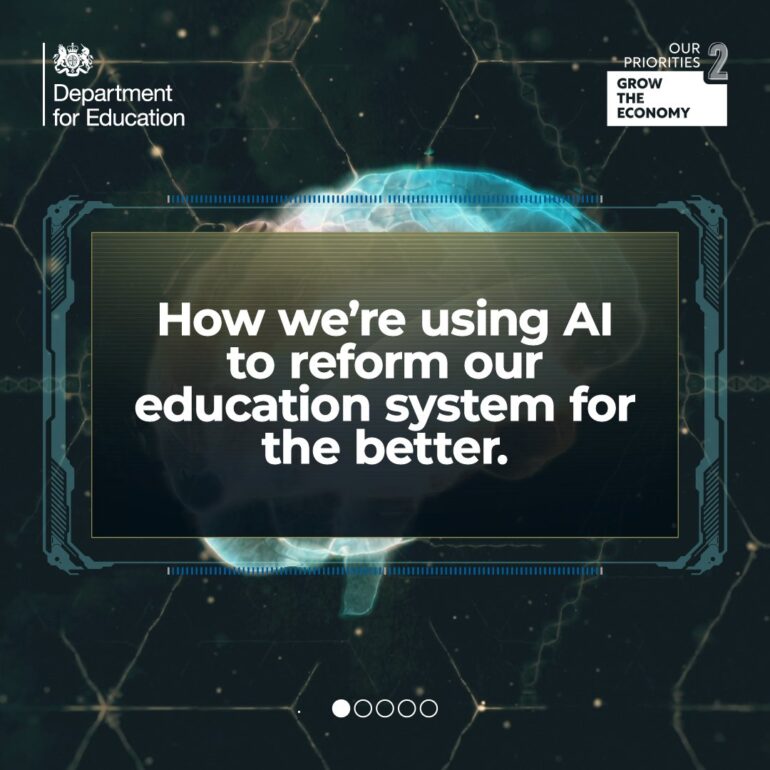TL;DR:
- UK government allocates £2 million for AI tools in education.
- Generative AI, like Open AI’s ChatGPT, has gained prominence in education.
- Teachers experiment with AI for lesson planning and resource creation.
- Tech giants and startups promote AI offerings to schools.
- AI’s appeal lies in workload reduction and teacher shortage mitigation.
- Potential drawbacks include devaluation of teaching expertise and standardized curriculum design.
- Quality control and accountability for AI-generated content are concerns.
Main AI News:
During the recent International AI Safety Summit hosted in the United Kingdom, the government made a significant announcement. An additional £2 million in funding will be allocated to Oak National Academy, a publicly funded classroom resource hub, with the aim of developing artificial intelligence (AI) tools designed to alleviate the burdens on teachers. This forward-looking initiative is set to revolutionize the educational landscape.
Generative AI, exemplified by Open AI’s ChatGPT, has become a focal point in the field of education. While comprehensive research on the utilization of AI by teachers remains scarce, it is evident from our engagements with schools that educators are embracing AI to craft lesson plans, create classroom materials, and establish teaching schemes. Imagine a scenario where a teacher requests ChatGPT, “produce a lesson plan on river flooding in Tewkesbury for year seven.” Within seconds, a meticulously structured plan materializes, encompassing learning objectives, teaching resources, activities, homework assignments, assessments, and more.
Technology titans like Google and Microsoft, alongside well-established education technology platforms like Khan Academy, are actively advocating for their AI solutions within the educational sphere. Moreover, startups and smaller educational enterprises are entering the arena, promising time-saving tools that can efficiently tackle the planning, ideation, and feedback processes that precede and follow classroom sessions.
The Appeal of AI in Education
Two key factors underscore the growing interest in AI among educators. The first factor is the mounting workload borne by teachers, leading to burnout and stress. It is alarming that 41% of all teachers contemplate leaving the profession within five years. The allure of AI lies in its ability to swiftly provide lesson plans, handouts, and student reports, aligning with government promises of reduced workloads and improved working conditions for teachers.
The second factor revolves around the scarcity of qualified teachers. Headteachers face formidable challenges in recruiting sufficient teaching staff, exacerbated by rising student enrollments and teacher attrition, combined with a dearth of new entrants to the profession. AI offers a viable solution to support educators in understaffed subject areas.
AI-generated lessons can source expert content, especially in subjects like mathematics or physics, which suffer from low recruitment numbers. These AI-designed lessons might potentially offer more relevant and precise content compared to lessons created by non-specialists.
The Hidden Risks
While there are undeniable benefits in terms of time efficiency and access to subject-specific content, we must critically examine how these AI tools might impact the teaching profession at large.
The use of generative AI for lesson planning may inadvertently undermine the role of scholarship in teaching. Teachers may transition into the role of executive technicians, focused on distributing worksheets and managing classroom behavior, rather than engaging in profound discussions about what should be taught, how, and the ethical considerations of education.
Furthermore, this shift towards treating teachers as technicians may fail to attract high-caliber graduates to the profession, which in turn could hinder the global competitiveness of our education system.
There is also a concern regarding the potential neglect of the unique needs and contexts of specific student groups when AI is employed to reduce teacher workloads. Curriculum and lesson design, which traditionally involve careful consideration of subject knowledge, skills, and the individual characteristics of students, may become overly standardized in AI-produced lessons.
Moreover, the development and maintenance of teaching expertise are at risk. Generative AI models are known to generate new facts and sources, a phenomenon sometimes referred to as “hallucinating,” while also displaying biases and discriminatory tendencies. This necessitates rigorous scrutiny of AI-generated content. However, if the intellectual work of lesson and curriculum planning is outsourced to AI tools and subsequently executed by non-specialist teachers, accountability for the quality, safety, and relevance of educational materials becomes blurred.
Conclusion:
The UK’s investment in AI for education signifies a growing trend in leveraging technology to ease the burden on teachers. While AI offers significant advantages in terms of efficiency, there are legitimate concerns about its impact on teaching expertise and the customization of education. As AI continues to shape the education landscape, market players should focus on providing robust, quality AI solutions that complement, rather than replace, the vital role of teachers in the classroom.

